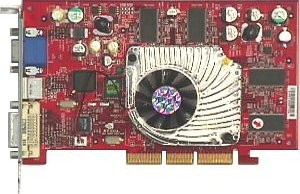Yesterday I was donated a new graphic card from a generous guy at the university, including cables, manual and bundled software, it is a nice MSI G4Ti4200-DT64 with red PCB.

It’s a good card but unfortunately it has only a primitive version of pixel shaders, they are neither floating point (supporting at most the proprietary “HILO” format) nor GLSL compliant, and they cannot be used via GL_ARB_fragment_program (as a matter of fact it is not present in the extensions array 🙁 ), but only through the family of GL_NV_register_combiners and GL_NV_texture_shader functions, which make use of the OpenGL state machine.
Nvidia Cg actually supports the fp20 profile, but its output is just a nvparse program, which has to be passed to a function that will setup GL texture states.
Anyway, let’s analyze what’s new going from a GeForce4 MX440-8X (NV18) to a GeForce4 Ti 4200 (NV25):
- The OpenGL version string hasn’t changed (mainly because of the lack of Shader Model 2.0), it is still 1.5.8.
- Thanks to the Accuview AA Engine there are three new anti-aliasing modes: 4x Bilinear Multisampling, 4x Gaussian Multisampling and 2x Bilinear Multisampling by 4x Supersampling.
- There are twenty new extensions available, most of them are related to multisample, depth textures, occlusion queries, shadows and texture shaders:
GL_ARB_depth_texture, GL_ARB_multisample, GL_ARB_occlusion_query, GL_ARB_shadow, GL_ARB_texture_border_clamp, GL_EXT_shadow_funcs, GL_EXT_texture3D, GL_EXT_timer_query, GL_HP_occlusion_test, GL_NV_copy_depth_to_color, GL_NV_depth_clamp, GL_NV_multisample_filter_hint, GL_NV_occlusion_query, GL_NV_register_combiners2, GL_NV_texture_compression_vtc, GL_NV_texture_shader, GL_NV_texture_shader2, GL_NV_texture_shader3, GL_SGIX_depth_texture, GL_SGIX_shadow.
Of course I performed some benchmarks too (have a look at Electron specs), all at 1024×768, except from glxgears and globs tests, they were run at the default 640×480 resolution.
Quake 3 was tested on the four.dm_68 demo with sound, Blender 2.42 was tested with the draw benchmark, while the GLSLvp_pointz test uses only vertex shader to move and color points.
Note that this last test is emulated in software on NV18 while is performed in hardware on the NV25, but shaders plus full scene anti-aliasing seem to be impossible to achieve on the latter.
| Test | NV18 | NV25 | ||
|---|---|---|---|---|
| NoAA, NoAF | 2xAA, 4xAF | NoAA, NoAF | 2xAA, 4xAf | |
| glxgears | 1568.5 | 833.5 | 2976.7 | 1571.7 |
| Blender | 2580 | 1580 | 7000 | 4484 |
| Quake 3 | 93.0 | 51.7 | 113.6 | 92.3 |
| gl_shadow | 296 | 148.4 | 674.6 | 360 |
| gl_pointz | 421.8 | 272.6 | 526.2 | 398.4 |
| gl_blit | 600.6 | 285.8 | 1197.4 | 612.4 |
| gl_smoke | 299 | 177.2 | 404.2 | 302 |
| GLSLvp_point | 118.6 | 103.8 | 317.6 | X |
The card is nice and fast, but the search for the fragment (extension) has not ended. 😉